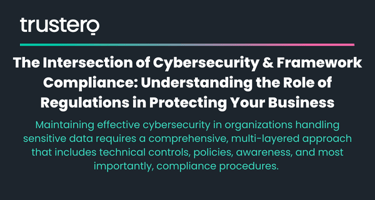As the world becomes increasingly digital, IT organizations are faced with a growing number of...
Addressing Common Engineering Compliance Requests
Engineering organizations and compliance have to work together in order to achieve a common goal. Engineering organizations need to design and develop products that are safe, effective, and meet all relevant standards and regulations. This helps to ensure that the end result is a product that is safe, reliable, and meets the expectations of all parties involved.
Why is Compliance Important to Engineering Organizations?
Compliance is important to engineering organizations because it helps to ensure that their products, processes, and operations meet industry standards and regulations. This can help to minimize the risk of legal and financial consequences, and it can demonstrate the company's commitment to privacy and security. Additionally, meeting compliance requirements can improve the company's reputation and increase customer trust.
What Are Common Engineering Compliance Requests That Need To Be Addressed?
Specific compliance requests will vary depending on the industry, the location, and the type of products or services offered. It's important for engineering organizations to stay up-to-date on all relevant regulations and standards in order to ensure that they are in compliance and minimize the risk of legal and financial consequences.
There are many different types of compliance requests that engineering organizations may need to address, but some common ones include:
SOC2: Is a set of standards for security, availability, processing integrity, confidentiality, and privacy. SOC2 is specifically designed for service organizations, such as cloud providers, that provide services to other organizations. SOC2 is an American Institute of Certified Public Accountants (AICPA) standard, it helps organizations to demonstrate their commitment to security and privacy to their customers and stakeholders.
ISO 27001: Is an international standard for information security management. It provides a framework for implementing, maintaining, and continually improving information security. The standard covers people, processes, and technology, and it helps organizations to identify and manage the risks to the confidentiality, integrity, and availability of their information. Organizations that are certified to ISO 27001 have demonstrated that they have implemented an information security management system (ISMS) that meets the standard's requirements.
Industry Standards: Many industries have established standards that must be met, such as ISO 9001 for quality management, UL safety standards for electrical products, and CE marking for products sold in the European Union.
Data Privacy Regulations: Engineering organizations that handle personal data must comply with regulations such as the General Data Protection Regulation (GDPR) and the California Consumer Privacy Act (CCPA).
Intellectual Property Regulations: Engineering organizations must respect the intellectual property rights of others and comply with patent and trademark laws.
Let’s Take a Look At An Example Request
Engineering organizations need to encrypt data at rest and implement cryptography to protect sensitive information and keep it confidential. This can include things like customer data, financial information, and trade secrets. By encrypting the data, the organization can ensure that it can only be accessed by authorized individuals with the proper key.
For example, Engineering organizations need to encrypt data at rest and implement cryptography.
- Objective: Secure Configuration Policy for the effective use of cryptography, including cryptographic key management, is defined and implemented.
- How to Handle It:
- Define and implement Secure Configuration policy
- Assess & monitor storage and transmission of information on endpoint devices or storage media
- Build standards to be adopted based on classification of information (sensitivity, criticality, etc.)
- Evaluate and implement cryptographic algorithms, cipher strength, cryptographic solutions, and usage practices
- Key Management requires secure processes for generating, storing, archiving, retrieving, distributing, retiring and destroying cryptographic keys.
Let’s Dive Deeper Into The “How To Handle It”
Encrypting data at rest and implementing cryptography is a process, and it's kind of like baking a cake. There are a few key ingredients and steps that need to be followed in order to get the best results.
Here's a high-level overview of the process:
- Identify sensitive data: Just like you need to know what ingredients you need for a cake, engineering organizations need to know what data they need to protect. This could include customer data, financial information, or trade secrets.
- Choose an encryption method: There are many different encryption methods to choose from, and each has its own strengths and weaknesses. Engineering organizations need to choose the right method that meets their specific needs and requirements.
- Implement encryption: This is where the encryption is actually applied to the data. It's kind of like mixing the ingredients together to make the batter for a cake.
- Store encrypted data: The encrypted data is then stored in a secure location, such as a database or cloud storage, to keep it safe from unauthorized access.
- Use cryptography: Cryptography can be used to secure communications between systems, or to provide additional protection for sensitive data. It's like putting frosting on the cake to make it even better.
- Monitor and update: Just like you need to keep an eye on a cake as it bakes, engineering organizations need to monitor their encryption and cryptography processes to make sure they are working as intended. They also need to regularly update their encryption methods and keys to stay ahead of evolving threats.
Learn more by downloading our eBook: Compliance Journey in the Age of SaaS


